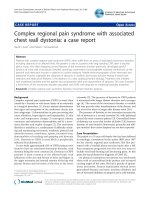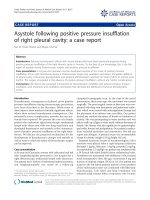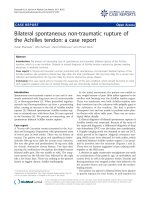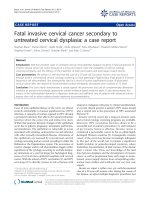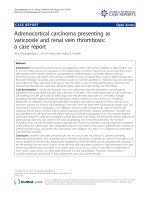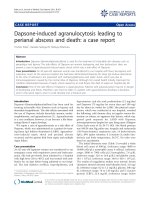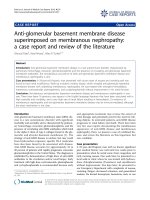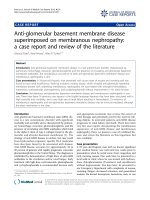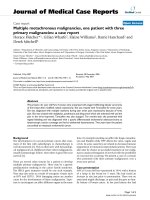Báo cáo y học: "Asystole following positive pressure insufflation of right pleural cavity: a case report" docx
Bạn đang xem bản rút gọn của tài liệu. Xem và tải ngay bản đầy đủ của tài liệu tại đây (270.98 KB, 3 trang )
CAS E RE P O R T Open Access
Asystole following positive pressure insufflation
of right pleural cavity: a case report
Kari M Forde-Thielen and Mojca R Konia
*
Abstract
Introduction: Adverse hemodynamic effects with severe bradycardia have been previously reported during
positive pressure insufflation of the right thoracic cavity in humans. To the best of our knowledge, this is the first
report of asystole during thoracoscopic surgery with positive pressure insufflation.
Case presentation: A 63-year-old Caucasian woman devel oped asystole at the onset of positive pressure
insufflation of her right hemithorax during a thoracoscopic single-lung ventilation procedure. Immediate deflation
of pleural cavity, intravenous glycopyrrolate and atropine administration returned her heart rhythm to normal sinus
rhythm. The surgery proceeded in the absence of positive pressure insufflation without any further complications.
Conclusions: We discuss the proposed mechanisms of hemodynamic instability with positive pressure thoracic
insufflation, and anesthetic and insufflation techniques that decrease the likelihood of adverse hemodynamic
events.
Introduction
Hemodynamic consequences of pleural cavity positive
pressure insufflation during thoracoscopic procedures
have been described in the literature. While some of
these reports show minimal clinically significant effects,
others show serious hemodynamic consequences. One
potentially severe complication, asystole, has not pre-
viously been reported. We present the case of a female
patient who underwent right thoracoscopic mediastinal
lymph node dissection with one-lung ventilation and
developed hypotension andasystoleatthecommence-
ment of positive pressure insufflation of her right hemi-
thorax. We discuss the proposed mechanisms for the
development of hemodynamic changes and asystole as
well as ways in which the safety of thoracoscopi c surgery
can be improved.
Case presentation
A 63-year-old Caucasian woman with subcarinal and left
hilar lymphadenopathy presented to our hospital for a
right thoracoscopic mediastinal lymph node dissection.
Our patient had a history of endometrial adenocarcinoma,
and lymphadenopathy was noted on a follow-up
computed tomography scan. A t the time of the initial
presentation, three years ago, the carcinoma was treated
surgically. The post-surgical course at that time was com-
plicated with deep vein thrombosis and pulmonary embo-
lism, which were treated with anticoagulation therapy and
the placement of an inferior vena cava filter. Our pat ient
denied any residual shortness of breath or limitation of
activity. She was participating in water aerobics and was
able to walk up a flight of stairs easily without shortness of
breath. Her history was also significant for gastroesopha-
geal reflux disease and dyslipidemia. Our patient’smedica-
tions included ranitidine and simvastatin. S he did not
report any allergies. A physical exam was unremarkable
except for obesity (weight 119 kg; height 165 cm).
Standard American Society of Anesthesiologists (ASA)
monitors were placed. After a rapid sequence induction
(fentanyl 1 μg/kg, lidocaine 1 m g/kg, propofol 2 mg/kg,
succinylcholine 1.5 mg/kg) our patient was intubated with
a 39 French left-sided double lumen endotracheal tube.
Anesthesia was maintained with desflurane 5-6%, fentanyl
(total intraoperative dose 300 μg), vecuronium 4 mg and
fraction of inspired oxygen (FiO2) at 1.0. Our patient was
turned to the left lateral position and the correct position
of the endotracheal tube was confirmed with fiberoptic
bronchoscopy. Left sided one-lung ventilation was
initiated (tidal volume 300cc, respiratory rate 16/min,
* Correspondence:
Department of Anesthesiology, University of Minnesota, Box 294, B515 Mayo
Memorial Building, 420 Delaware Street, SE, Minneapolis, MN 55455, USA
Forde-Thielen and Konia Journal of Medical Case Reports 2011, 5:257
/>JOURNAL OF MEDICAL
CASE REPORTS
© 2011 Forde-Thie len and Konia; licens ee BioMed Central Ltd . This is an Open Access article distributed under the terms of the
Creative Commons Attr ibution License ( g/licenses/by/2.0), which permits unrestrict ed use, distribution, and
reproduction in any medium, provided the original work is properly cited.
positive-pressure respiration (PEEP) 4, FiO2 1.0). Incisions
were made soon after initiation of one-lung ventilation,
and ports were inserted. Vitals signs at the time of incision
included saturated oxygen 99-100%, noninvasive blood
pressure 150/75 mmHg and pulse 80/min. Her right hemi-
thorax was insufflated with carbon dioxide to a pressure of
10 mmHg at a rate of 25 L/min. At this point in the proce-
dure we noted changes in our patient’s hemodynamic sta-
tus. Her blood pressure dropped to 112/63 and her heart
rate precipitously dropped to 35/min for a few seconds.
This was followed by asystole. The surge on was notified,
insufflation was stopped and glycopyrrolate 0.4 mg and
atropine 0.4 mg were administered. Within 10 seconds of
pleural deflation our patient resumed a normal sinus
rhythm. Her next blood pressure reading was 125/75. In
the absence of further rhythm or hemodynamic abnormal-
ities the surgery was continued. The pleural cavity was
slowly insufflated to a pressure of 8 mmHg and the case
progressed without any further complications. Our patient
had an uncomplicated post-operative course.
Discussion
Insufflation of the pleural cavity with carbon dioxide is
believed by some to facilitate lung deflation during one-
lung ventilation and improve surgical exposure. Insuffla-
tion also enlarges the intrapleural space by pushing the
mediastinum away from the operative field [1]. The tech-
nique is often used in thoracoscopic harvesting of the
internal mammary artery. The practice of insufflation has
further been used successfully in collapsing emphysema-
tous lung [1]. It has, however, been suggested that insuffla-
tion is unnecessary for adequate exposure in the majority
of thoracoscopic surgeries and may increase the risk of
hemodynamic compromise [2-4]. It has also been sug-
gested that opening a port to air is safer than and just as
effective as insufflations [5].
The initial reports of significant hemodynamic compro-
mise during positive pressure insufflation of the pleural
cavity came from pig studies [6]. The anatomy and phy-
siology of a pig, however, is significantly different from
that of a human [7]. Based on human studies, most
authors agree that insufflation of the hemithorax up to a
pressure of 10 mmHg with one-lung ventilation causes
some hemodynamic change. Right-sided insufflation
causes more pronounced hemodynamic effect compared
to left-sided insufflation because the right heart is a low-
pressure system [1,5,6]. Human studies have demonstrated
that positive pressure insufflation of the right or left
pleural cavity increases central venous pressure (CVP) by
4-10 mmHg [1,7,8] and pulmonary artery (PA) pressure
by 2-7 mmHg [1,7], which ultimately results in a decrease
in preload. The effects of positive pressure insufflation of
the pleural cavity have less significant effects on systemic
pressures and cardiac function [3,4,7-9].
There are several theories that explain the mechanisms
of hemodynamic changes. Positive pressure insufflation
of the thoracic cavity creates physiologic effects similar to
a tension pneumothorax [6]. This effect can explain the
increase in CVP and decrease in venous return. More
pronounced effects in certain reports could be explained
by higher than intended intrathoracic pressures caused
by incomplete lung collapse at initiation of pleural cavity
insufflation. In this situation the pleural pressure may
increase enough to close off the small airways. Respira-
tory gases get trapped in the lung and further insufflation
induc es a rapid increase in intrathoracic pressure instead
of collapsing the lung. The high intrathoracic pressure
further reduces venous return and lowers the cardiac
output [5].
Increases in mean PA pressure and pulmonary capillary
wedge pressure may be caused by positive intrapleural
pressure together with hypoxic pulmonary vasoconstric-
tion in the collapsed pulmonary parenchyma [1,7].
There are no pr ior reports of asystole on commence-
ment of pleural insufflation during one-lung ventilation
in the human literature. However, Harris et al. reported a
case of seve re bradycardia following hypotension during
right-sided thoracoscopic dorsal sympathectomy with
insufflation up to a pressure of 15 mmHg [5]. Our case
began with mild hypotension and bradycardia which pro-
gressed to asystole, suggesting that these hemodynamic
changes are all part of a spectrum of derangements
caused by the same inciting mechanism.
The incidence and mechanisms of bradycardia and asys-
tole are poorly defined. Besides the hemodynamic effects
described above, increased intrathoracic pressure could
cause direct vagal stimulation and thereby induce brady-
cardia or asystole. Some authors have proposed a Bezold-
Jarisch reflex as an underlying mechanism [5]. The
Bezold-Jarisch reflex occurs when a patient with an intact
autonomic nervous system experiences hypotension. This
is sensed by baroreceptors in the aortic arch and carotid
sinuses, which compensate with greatly increased cardiac
contractility. The cardiac baroreceptors then sense this
high intramural tension and induce significant parasympa-
thetic discharge resulting in bradycardia or asystole.
To explain asystole in our patient, we turn to the
sequence of events to help elucidate the pathophysiology.
After positioning of our patient and preparation of the
surgical field we initiated on e-lung ventilation. Ports
were immediately inserted and positive pressure insuffla-
tion of her right pleural cavity with high flows (25 L/min)
to a pressure of 1 0 mmHg was started. Full deflation of
the lung was not carefully assessed prior to positive pres-
sure insufflation. As demonstrated by Jacobs et al., the
actual pressure in an insuffla ted cavity may briefly be
much higher than the insufflator pressure presetting [10].
Temporary deviations of up to 78.8% from the displayed
Forde-Thielen and Konia Journal of Medical Case Reports 2011, 5:257
/>Page 2 of 3
pressure were observed during their study in laparoscopic
procedures. We propose that the lung of our patient was
not fully deflated at initiation of insufflation. The
intrathoracic pressure increased instanta neously with
high flows of insufflation and most likely exceeded
10 mmHg, at least temporarily. This caused a pro-
nounced mediastinal shift, an immediate drop in venous
return,withlittletimeforthesympatheticnervoussys-
tem to slowly compensate, and either vagal stimulation
or activation of the Bezold-Jarisch reflex l eading to
asystole.
Conclusion
In the literature it is suggested that insufflation flows
should be kept at 2-3 L/min [1,5,7]. In the authors’
experience the insufflation flows vary and high flows are
often utilized, which may not promote patient safety.
Also, with rapid insufflation using high flows the insuf-
flator may overshoot and increase intrathoracic pressure
over the safe limit. We therefore propose that, to pre-
vent events like this from occurring, insufflation pres-
sures should be kep t below 10 mmHg [5,9]. We suggest
giving enough time for full deflation of the lung. It
would be prudent to initiate one-lung ventilation as
soon as possible and use 100% oxygen to accelerate lung
deflation [11]. It ha s also previou sly been recommende d
that the lung should be exposed to ambient pressure for
60 seconds before the ini tiation of insufflations [5]. This
will allow for hypoxic pulmonary vasoconstriction to
limit shunting and for the sympathetic response to com-
pensate for decreased venous return. Insufflation should
be used primarily in patients with unsatisfactory surgical
exposure following passive lung deflation.
Consent
Written informed consent was obtained from the patient
for publication of this case report. A copy of the written
consent is available for review by the Editor-in-Chief of
this journal.
Authors’ contributions
Both authors participated in the clinical care of the patient and participated
in the collection and review of the literature and writing of the case report.
Both authors have read and approved the final manuscript.
Competing interests
The authors declare that they have no competing interests.
Received: 13 October 2010 Accepted: 30 June 2011
Published: 30 June 2011
References
1. Ohtsuka T, Nakajima J, Kotsuka Y, Takamoto S: Hemodynamic responses to
intrapleural insufflation with hemipulmonary collapse. Surg Endosc 2001,
15(11):1327-1330.
2. Stensrud PE: Anesthesia for Thoracoscopy. Semin Cardiothorac Vasc Anesth
2000, 4(1):18-25.
3. Vassiliades TA Jr: The cardiopulmonary effects of single-lung ventilation
and carbon dioxide insufflation during thoracoscopic internal mammary
artery harvesting. Heart Surg Forum 2002, 5(1):22-24.
4. Brock H, Rieger R, Gabriel C, Polz W, Moosbauer W, Necek S:
Haemodynamic changes during thoracoscopic surgery the effects of
one-lung ventilation compared with carbon dioxide insufflation.
Anaesthesia 2000, 55(1):10-16.
5. Harris RJ, Benveniste G, Pfitzner J: Cardiovascular collapse caused by
carbon dioxide insufflation during one-lung anaesthesia for
thoracoscopic dorsal sympathectomy. Anaesth Intensive Care 2002,
30(1):86-89.
6. Hill RC, Jones DR, Vance RA, Kalantarian B: Selective lung ventilation
during thoracoscopy: effects of insufflation on hemodynamics. Ann
Thorac Surg 1996, 61(3):945-948.
7. Ohtsuka T, Imanaka K, Endoh M, Kohno T, Nakajima J, Kotsuka Y,
Takamoto S: Hemodynamic effects of carbon dioxide insufflation under
single-lung ventilation during thoracoscopy. Ann Thorac Surg 1999,
68(1):29-32, discussion 32-33.
8. Wolfer RS, Krasna MJ, Hasnain JU, McLaughlin JS: Hemodynamic effects of
carbon dioxide insufflation during thoracoscopy. Ann Thorac Surg 1994,
58(2):404-407, discussion 407-408.
9. Byhahn C, Mierdl S, Meininger D, Wimmer-Greinecker G, Matheis G,
Westphal K: Hemodynamics and gas exchange during carbon dioxide
insufflation for totally endoscopic coronary artery bypass grafting. Ann
Thorac Surg 2001, 71(5):1496-1501, discussion 1501-1502.
10. Jacobs VR, Morrison JE Jr: The real intraabdominal pressure during
laparoscopy: comparison of different insufflators. J Minim Invasive Gynecol
2007, 14(1):103-107.
11. Ko R, McRae K, Darling G, Waddell TK, McGlade D, Cheung K, Katz J,
Slinger P: The use of air in the inspired gas mixture during two-lung
ventilation delays lung collapse during one-lung ventilation. Anesth
Analg 2009, 108(4):1092-1096.
doi:10.1186/1752-1947-5-257
Cite this article as: Forde-Thielen and Konia: Asystole following positive
pressure insufflation of right pleural cavity: a case report. Journal of
Medical Case Reports 2011 5:257.
Submit your next manuscript to BioMed Central
and take full advantage of:
• Convenient online submission
• Thorough peer review
• No space constraints or color figure charges
• Immediate publication on acceptance
• Inclusion in PubMed, CAS, Scopus and Google Scholar
• Research which is freely available for redistribution
Submit your manuscript at
www.biomedcentral.com/submit
Forde-Thielen and Konia Journal of Medical Case Reports 2011, 5:257
/>Page 3 of 3

